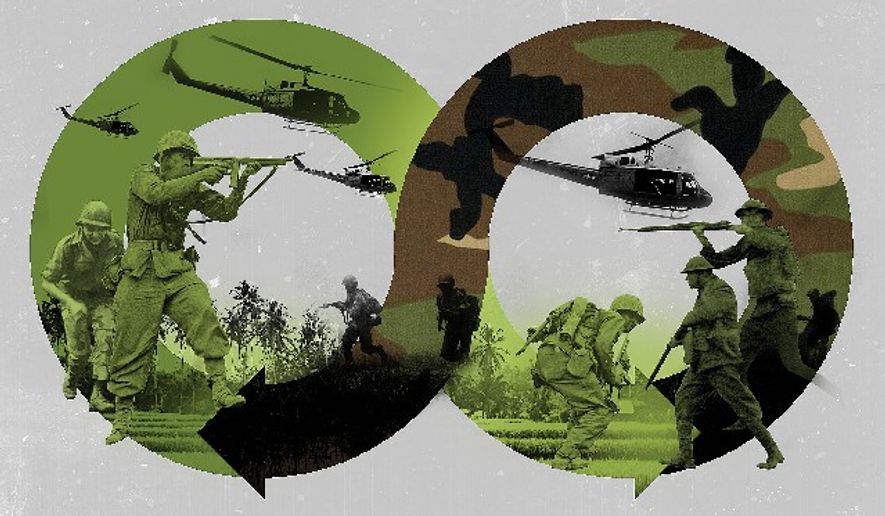OPINION:
“Only the dead have seen the end of war.” Plato made that incisive observation a rather long time ago. Yet, a surprising number of politicians, journalists and think tank denizens continue to affix bumper stickers to their Priuses (if they’re on the left) and SUVs (if they’re on the right) demanding an end to “endless wars.”
President Obama’s approach to national security was based on the comforting notion that the “the tide of war is receding.” He vowed “to bring the war in Iraq to a responsible end,” and to “bring our troops home from Afghanistan.” The possibility of a linkage between these two battlegrounds didn’t occur to him.
His withdrawal from Iraq in 2011 was followed by the rise of the Islamic State. Three years later, he would reluctantly send U.S. troops back to Iraq.
He would go on to give the revolutionary Islamists next door in Iran — responsible for killing hundreds of Americans — billions of dollars in exchange for their promise to develop nuclear weapons more slowly. Though this was, for them, the deal of the century, that did not prompt them to revise their often-chanted goal of “Death to America!”
Mr. Obama also signaled to the Taliban that its patience and determination would pay off — just, please, not on his watch.
Given this background, President Trump now faces tough choices. While he, too, is eager to end endless wars, he also aims to “make America great again.” Can that be achieved with Obama 2.0 policies? Can that be achieved if self-proclaimed jihadis — Sunni or Shia, Persian, Arab or Afghan — have Americans on the run?
Wars have shaped history, but the ways wars are fought evolve. Americans grew accustomed to relatively short, high-intensity conflicts with a decisive conclusion. Our contemporary enemies prefer long, low-intensity conflicts that, they believe, will wear us out over time. And they get a vote.
In truth, most wars of the past were not as cut-and-dry as they appear in hindsight. The conflict that began in 1914 was not “the war to end all wars.” Just 20 years after the formal conclusion of that conflict, World War II began.
In that global struggle, America’s aim was to prevent totalitarian empires from conquering Europe and Asia. Following the defeat of the Third Reich, however, much of Europe would be dominated by the no-less-totalitarian Soviet Empire. So, Americans next fought the long, twilight struggle known as the Cold War.
Though we prevailed, Russia today is not an ally. And China, of course, now seeks hegemony in Asia and beyond. The theory — really more of a hope — that China’s Communist rulers would slowly but surely moderate has been disproven, a fact the Trump administration, unlike its predecessors, has been realistic enough to recognize.
The academic literature on the longevity of war is worth consulting. For example, in 2003, Walter Laqueur, who then held a chair at the Center for Strategic and International Studies, wrote a book titled “No End to War.” In 2014, Christopher Corker, a professor at the London School of Economics, wrote a book asking, “Can War Be Eliminated?” (His answer: No.) Raymond Ibrahim’s “Sword and Scimitar,” published last year, documents a war against the West that began 14 centuries ago.
A paradox: The mightier our military the less often we’re likely to send it into battle. There’s an ancient Latin adage for that: Si vis pacem, par bellum, if you want peace, prepare for war. Ronald Reagan preferred “Peace through strength.” Sun Tzu and Clausewitz offered similar advice. The flip side of this coin: Weakness and irresolution invite aggression.
When we do decide to fight, it is imperative that our strategies be superior to those of our opponents. I’d argue that doesn’t mean devising “exit strategies.” Instead, we should have a coherent “theory of victory” for any conflict judged to be in the American interest.
It also means having reasonable expectations: Transforming Afghanistan into Costa Rica is not within the realm of the possible. Preventing Afghanistan from again becoming a terrorist playground: perhaps doable.
Dan Crenshaw, a former Navy SEAL and now a member of Congress, makes the case for the modest concept of “mission success.”
For example, in Syria at the moment, a few hundred highly skilled American troops, supporting Arab and Kurdish partners, are both preventing a revival of the Islamic State and helping contain the Islamic Republic of Iran. This is a textbook example of “economy of force” — much preferable to sending in hundreds of thousands of troops or pulling out all forces, leaving a vacuum our enemies quickly fill.
“Bring our boys home!” is a nice slogan, but as Rep. Crenshaw also pointed out, the men and women volunteering to serve in America’s armed forces are not doing so in order to hang around the house drinking brewskies.
They are taking the fight to the bad guys, ensuring that America’s enemies cannot plot in comfort and safety, and hindering their efforts to bring the war home to us. America’s professional warriors deserve to be applauded, not patronized.
Back in the 1960s, the hippies had a saying: “Suppose they gave a war and nobody came.” The chowderheads at such groups as Code Pink will never understand that America’s enemies will keep on coming so long as they think they have a chance to damage, defeat and destroy us.
That prominent politicians, journalists and think-tank denizens on both the left and the right also cling to such fantasies is both disappointing and distressing.
• Clifford D. May is founder and president of the Foundation for Defense of Democracies (FDD) and a columnist for The Washington Times.




Please read our comment policy before commenting.